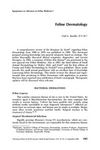TLDR Feline pododermatitis is less common in cats than in dogs.
The article discussed feline pododermatitis, which occurred less frequently in cats compared to dogs. It covered the clinical presentation, diagnosis, and management of common conditions associated with this ailment. Trombiculidiasis and bacterial paronychia were identified as the most common infections in cats, while fungal infections, though rare, were also significant. Other less frequent but important causes included atopic disease, cutaneous adverse food reactions, pemphigus foliaceus, plasma cell pododermatitis, and paraneoplastic alopecia (metabolic epidermal necrosis).
64 citations
,
December 2003 in “Veterinary Dermatology” Triamcinolone is more effective and safer for treating feline pemphigus foliaceus than prednisone.
105 citations
,
December 2003 in “Veterinary Dermatology” Skin disorders in pets can help detect hidden cancers early.
 48 citations
,
March 1997 in “Veterinary Dermatology”
48 citations
,
March 1997 in “Veterinary Dermatology” Some cats with sudden hair loss and tiredness might have cancer-related alopecia.
 August 2001 in “Veterinary Dermatology”
August 2001 in “Veterinary Dermatology” The meeting presented findings on effective treatments for various pet skin conditions and insights into the immune responses of dogs with atopic dermatitis.
 15 citations
,
September 1984 in “Veterinary Clinics of North America: Small Animal Practice”
15 citations
,
September 1984 in “Veterinary Clinics of North America: Small Animal Practice” The document explains various skin conditions in cats and how to diagnose and treat them.
 September 2016 in “Elsevier eBooks”
September 2016 in “Elsevier eBooks” Different types of hair loss in dogs and cats have various causes and treatments, with outcomes ranging from good to uncertain.
 January 2011 in “Elsevier eBooks”
January 2011 in “Elsevier eBooks” Alopecia in animals can be hereditary, congenital, or acquired, with treatments and outcomes varying widely.
 14 citations
,
May 2013 in “Emerging infectious diseases”
14 citations
,
May 2013 in “Emerging infectious diseases” Cryptococcus gattii can remain dormant in animals for over 8 years.





